OpenADR 2.0b Profile Specification
- 1 -
OpenADR 2.0
Profile Specification
B Profile
Updated 07-01-2013
Revision Number: 1.0
Document Status: Final Specification
Document Number: 20120912-1
Copyright© OpenADR Alliance® (2013). All rights Reserved. The information within this document
is the property of the OpenADR Alliance® and its use and disclosure are restricted.
Contact:
Editors:
OpenADR Alliance
275 Tennant Avenue, Suite 202
Morgan Hill, CA 95037
help@openadr.org
Ulrich Herberg, Fujitsu
Jim Zuber, QualityLogic
Technical Director
OpenADR Alliance:
Rolf Bienert
Please send general questions and comments about the specification to comments@openadr.org
Copyright © OpenADR Alliance (2013). All Rights Reserved.
�OpenADR 2.0b Profile Specification
- 2 -
Legal Notice
© 2013 OpenADR Alliance.
The OpenADR Alliance hereby grants the party downloading this technical specification (“You” and the
“Specification” respectively) a non-exclusive, non-transferable, royalty free, nonsublicenseable limited
copyright license to download the Specification, exclusively for the purpose of internal evaluation. You un-
derstand and expressly acknowledge that this limited copyright license is revocable at any time for any
reason, or no reason. You also agree not to modify the Specification in any way and agree not to make,
have made, or in any way participate in the making of derivative works thereof, other than as a necessary
result of reviewing and providing feedback to the Specification. The OpenADR Alliance expressly reserves
all rights not granted pursuant to this limited copyright license. OpenADR Alliance Members can use the
spec as per the Alliance Intellectual Property Policy.
You also acknowledge that the Specification may be superseded by the publication of a revised or amend-
ed Specification (“Future Specification”), at which time the limited copyright license granted herein will au-
tomatically be revoked. You are therefore cautioned against relying on the content of this Specification.
EXCEPT FOR THE LIMITED COPYRIGHT LICENSE GRANTED ABOVE, THE OPENADR ALLIANCE
DOES NOT GRANT, EITHER EXPRESSLY OR IMPLIEDLY, A LICENSE TO ANY INTELLECTUAL PROP-
ERTY IT, OR ANY THIRD PARTIES, OWN OR CONTROL. ANY IMPLEMENTATION OF THE SPECIFICA-
TION WILL CONSTITUTE COPYRIGHT AND/OR PATENT INFRINGEMENT. Title to the copyright in the
Specification will at all times remain with the OpenADR Alliance. The example companies, organizations,
products, domain names, e-mail addresses, logos, people, places, and events depicted therein are ficti-
tious. No association with any real company, organization, product, domain name, email address, logo,
person, place, or event is intended or should be inferred.
THE SPECIFICATION IS PROVIDED “AS IS,” AND THE OPENADR ALLIANCE (AS WELL AS ANY THIRD
PARTIES THAT HAVE CONTRIBUTED TO THE SPECIFICATION INCLUDING WITHOUT LIMITATION
MEMBERS OF THE OPENADR ALLIANCE) MAKES NO REPRESENTATIONS OR WARRANTIES, EX-
PRESS OR IMPLIED, INCLUDING, BUT NOT LIMITED TO, WARRANTIES OF MERCHANTABILITY, FIT-
NESS FOR A PARTICULAR PURPOSE, NON-INFRINGEMENT, OR TITLE; THAT THE CONTENTS OF
THE SPECIFICATION ARE SUITABLE FOR ANY PURPOSE; NOR THAT THE IMPLEMENTATION OF
SUCH CONTENTS WILL NOT INFRINGE ANY THIRD PARTY PATENTS, COPYRIGHTS, TRADEMARKS
OR OTHER RIGHTS.
NEITHER THE OPENADR ALLIANCE NOR ANY THIRD PARTY WILL BE LIABLE FOR ANY DIRECT, IN-
DIRECT, SPECIAL, INCIDENTAL OR CONSEQUENTIAL DAMAGES ARISING OUT OF OR RELATING TO
ANY USE OF THE SPECIFICATION.
The OpenADR Alliance is willing to receive input, suggestions and other feedback (“Feedback”) on the
Specification. By providing such Feedback to the OpenADR Alliance, you grant to the OpenADR Alliance
and all its Members a non-exclusive, non-transferable, worldwide, perpetual, irrevocable, royalty-free copy-
right license to copy, publish, license, modify, sublicense or otherwise distribute and exploit your Feedback
for any purpose. Likewise, if incorporation of your Feedback would cause an implementation of the Speci-
fication or a Future Specification to necessarily infringe a patent or patent application that you own or con-
trol, you hereby commit to grant to all implementers of such Specification or Future Specification an irrevo-
cable, worldwide, sublicenseable, royalty free license under such patent or patent application to make,
have made, use, sell, offer for sale, import and export products or services that implement such Specifica-
tion or Future Specification. You warrant that (a) to the best of your knowledge you have the right to pro-
vide this Feedback, and if you are providing Feedback on behalf of a company, you have the rights to pro-
vide Feedback on behalf of your company; (b) the Feedback is not confidential to you and does not violate
the copyright or trade secret interests of another; and (c) to the best of your knowledge, use of the Feed-
back would not cause an implementation of the Specification or a Future Specification to necessarily in-
fringe any third-party patent or patent application known to you. You also acknowledge that the OpenADR
Alliance is not required to incorporate your Feedback into any version of the Specification or a Future
Specification.
Copyright © OpenADR Alliance (2013). All Rights Reserved.
�
OpenADR 2.0b Profile Specification
- 3 -
CONTENTS
1 Scope ............................................................................................................................ 10
2 Normative References .................................................................................................... 12
3 Non-Normative References ............................................................................................ 14
4 Terms and Definitions .................................................................................................... 15
5 Abbreviations ................................................................................................................. 16
6 Overview ........................................................................................................................ 17
6.1 Node and Device Types ........................................................................................ 18
6.2 Energy Interoperation Services ............................................................................. 19
6.3 Feature Sets ......................................................................................................... 19
6.4 Assumptions ......................................................................................................... 20
7 OpenADR 2.0 Feature Set Profiles ................................................................................. 21
7.1 Differences between OpenADR 2.0a and OpenADR 2.0b ...................................... 21
7.2 OpenADR 2.0b Feature Set Profile........................................................................ 22
7.2.1 Supported Services ................................................................................... 22
7.2.2 Report Only VENs ..................................................................................... 22
7.2.3 Transport Mechanism ................................................................................ 23
7.2.4 Security ..................................................................................................... 23
8 OpenADR 2.0b Services and Data Models Extensions ................................................... 24
8.1 OpenADR 2.0b EiEvent Service ............................................................................ 24
8.1.1 Data Model ............................................................................................... 28
8.1.2 UML Models .............................................................................................. 28
8.2 Differences between OpenADR2.0a and 2.0b Event Mechanism ........................... 30
8.2.1 Event Targets and Resources ................................................................... 30
8.2.2 OpenADR 2.0b Signal Definitions .............................................................. 30
8.3 OpenADR 2.0b Report Service .............................................................................. 34
8.3.1
Introduction ............................................................................................... 34
8.3.2 Core Reporting Operations ........................................................................ 35
8.4 OpenADR 2.0b Registration Service ..................................................................... 42
8.4.1 Service Operations .................................................................................... 42
8.4.2 Registration Information ............................................................................ 45
8.5 OpenADR 2.0b EiOpt Service ............................................................................... 47
8.5.1 Service Operations .................................................................................... 47
8.5.2 Detail Requirements .................................................................................. 48
8.6 OpenADR Poll ....................................................................................................... 50
8.7 Application Error Codes ........................................................................................ 53
9 Transport Protocol ......................................................................................................... 54
9.1 Simple HTTP......................................................................................................... 54
9.1.1 PUSH and PULL implementation ............................................................... 54
9.1.2 Service Endpoint URIs .............................................................................. 54
9.1.3 HTTP Methods .......................................................................................... 55
Copyright © OpenADR Alliance (2013). All Rights Reserved.
�
OpenADR 2.0b Profile Specification
- 4 -
9.1.4 Failure Conditions ..................................................................................... 55
9.1.5 HTTP Response Codes ............................................................................. 55
9.1.6 Message Timeouts .................................................................................... 56
9.1.7 Message Retry / Quiesce Behavior ............................................................ 56
9.1.8 PULL Timing ............................................................................................. 56
9.1.9 HTTP Headers .......................................................................................... 56
9.2 Transport Specific Security ................................................................................... 57
9.3 XMPP ................................................................................................................... 57
9.3.1 PUSH and PULL implementation ............................................................... 58
9.3.2 Service Endpoints ..................................................................................... 58
9.3.3 Service Execution ..................................................................................... 58
9.3.4
Implementation of XMPP Features for OpenADR....................................... 58
9.3.5 Security Considerations ............................................................................ 62
10 OpenADR 2.0 Security ................................................................................................... 63
10.1 Architecture and Certificate Types ........................................................................ 63
10.2 Certificate Authorities ............................................................................................ 64
10.3 Certificate Revocation ........................................................................................... 64
10.4 TLS and Cipher Suites .......................................................................................... 64
10.5 System Registration Process ................................................................................ 65
10.5.1 Certificate Fingerprints .............................................................................. 65
10.6 Implementing XML Signatures for OpenADR 2.0 Message Payloads ..................... 65
10.6.1 Introduction to XML Signature ................................................................... 65
10.6.2 Components of XML Signatures ................................................................ 66
10.6.3 Creating XML Signatures .......................................................................... 66
10.6.4 Verifying XML Signatures .......................................................................... 68
11 Conformance ................................................................................................................. 69
11.1 OpenADR 2.0 conformance statement .................................................................. 69
11.2 OpenADR 2.0b Profile Conformance Rules ........................................................... 69
11.2.1 EiEvent – from 2.0a ................................................................................... 69
11.2.2 EiEvent – Additional 2.0b Conformance Rules ........................................... 79
11.2.3 EiOpt......................................................................................................... 81
11.2.4 EiReport .................................................................................................... 85
11.2.5 EiRegisterParty ......................................................................................... 93
11.2.6 General Conformance Rules ..................................................................... 95
11.3 Cardinality .......................................................................................................... 101
11.4 Services used from OASIS Energy Interoperation V1.0 Standard ........................ 101
11.5 Services not currently used from OASIS EI ......................................................... 102
Annex A – Detailed Report Description ............................................................................... 103
Annex B B Profile Extensions ............................................................................................. 104
B.1 Overview ............................................................................................................. 104
B.2 Report Extension ................................................................................................ 104
B.3 Signal Extensions ............................................................................................... 104
B.4 Other Extensions ................................................................................................ 104
Copyright © OpenADR Alliance (2013). All Rights Reserved.
�
OpenADR 2.0b Profile Specification
- 5 -
Annex C – oadrPoll Scenarios ............................................................................................ 105
C.1 Overview ............................................................................................................. 105
C.2 Scenarios ............................................................................................................ 105
Copyright © OpenADR Alliance (2013). All Rights Reserved.
�
OpenADR 2.0b Profile Specification
- 6 -
OPEN AUTOMATED DEMAND RESPONSE
OpenADR 2.0 Profile Specification
FOREWORD
The development of the Open Automated Demand Response Communications Specification,
also called OpenADR, began in 2002 following the California electricity crisis. The California En-
ergy Commission Public Interest Energy Research Program funded an OpenADR research pro-
gram through the Demand Response Research Center (DRRC) at Lawrence Berkeley National
Laboratory (LBNL). OpenADR development began in 2002 to support California’s energy policy
objectives to move toward dynamic pricing to improve the economics and reliability of the electric
grid. Initial field tests focused on automating a number of event-based DR utility programs for
commercial and industrial (C&I) customers. The DRCC research set out to determine if today’s
communications and information technologies could be used to automate Demand Response (DR)
operations using standardized electricity price and reliability signals. This research, development,
and deployment have led to commercial adoption of OpenADR. Today, utilities and governments
worldwide are using OpenADR to manage the growing demand for electricity and peak capacity
of the electric systems. This low cost communications infrastructure is used to improve the relia-
bility, repeatability, robustness, and cost-effectiveness of DR.
OpenADR is a fundamental element of U.S. Smart Grid interoperability standards being devel-
oped to improve optimization between electric supply and demand. OpenADR is designed to fa-
cilitate automated DR actions at the customer location, whether it involves electric load shedding
or shifting. OpenADR is also designed to provide continuous dynamic price signals such as hour-
ly day-ahead or day-of real time pricing. OpenADR has been field tested and deployed in a num-
ber of DR programs in U.S and worldwide. While the scope of OpenADR focuses on signals for
DR events and prices, significant work focuses on DR strategies and techniques to automate DR
within facilities. OpenADR interacts with facility control systems that are pre-programmed to take
action based on a DR signal, enabling a response to a DR event or a price to be fully automated,
with no manual intervention.
The DRCC OpenADR 1.0 specification was donated to the Organization of Structured Infor-
mation Standards (OASIS) to create a national standard for OpenADR. The OASIS’ Energy In-
teroperation (EI) Technical Committee (TC) developed a standard to describe “an information
model and a communication model to enable collaborative and transactive use of energy, service
definitions consistent with the OASIS SOA Reference Model [SOA-RM], and XML vocabularies
for the interoperable and standard exchange of dynamic price signals, reliability signals, emer-
gency signals, communication of market participation information such as bids, load predictability
and generation information.” Considering that the goal of OASIS EI TC was more than DR and
Distributed Energy Resources (DER), the EI TC created profiles within the EI Version 1.0 stand-
ard for specific applications within the Smart Grid. The OpenADR Alliance used the EI OpenADR
profile as the basis for the OpenADR 2.0 Profile Specification defined in this document. Open-
ADR 2.0 defines profiles for DR and Distributed Energy Resources (DER), while keeping in mind
the requirements of the diverse market and stakeholder needs.
Copyright © OpenADR Alliance (2013). All Rights Reserved.
�
OpenADR 2.0b Profile Specification
- 7 -
INTRODUCTION
Development of the Demand Response (DR) market has resulted in a transition from manual DR
to OpenADR in Automated DR (Auto-DR) programs. As of 2013, over 250 MW was enrolled in
California commercial and industrial customers Auto-DR programs using OpenADR 1.0.1 DR is
defined as “…action taken to reduce electricity demand in response to price, monetary incentives,
or utility directives so as to maintain reliable electric service or avoid high electricity prices.” 2
OpenADR 1.0 was developed to support Auto-DR programs and California’s energy policy objec-
tives to move toward dynamic pricing to improve the economics and reliability of the electric grid.
The recent developments have expanded the use of OpenADR to meet diverse market needs
such as ancillary services (Fast DR), dynamic prices, intermittent renewable resources, supple-
ment grid-scale storage, electric vehicles, and load as generation. For example, with real-time
price information, an automated client within the customer facility can be designed to continuous-
ly monitor these prices and translate this information into continuous automated control and re-
sponse strategies. This rationale is a fundamental element of the United States (U.S.) Smart Grid
interoperability standards, which are developed to improve dynamic optimization of electric sup-
ply and demand.
OpenADR Communications have the following defining features:
� Continuous, Secure, and Reliable - Provides continuous, secure, and reliable two-way
communications infrastructures where the end points at the end-use site receive and
acknowledge the receipt of DR signals from the energy service providers.
� Translation - Translates DR event information to continuous Internet signals to facilitate
DR automation. These signals are designed to interoperate with energy management and
control systems, lighting, or other end-use controls.
� Automation - Receipt of the external signal is designed to initiate automation through the
use of pre-programmed demand response strategies determined and controlled by the
end-use participant.
� Opt-Out - Provides opt-out or override function to any participants for a DR event if the
event comes at a time when changes in end-use services are not desirable.
� Complete Data Model - Describes a rich data model and architecture to communicate
price, reliability, and other DR activation signals.
� Scalable Architecture - Provides scalable communications architecture to different
forms of DR programs, end-use buildings, and dynamic pricing.
� Open Standards - Open standards-based technology such as Internet Protocol (IP) and
web services form the basis of the communications model.
OpenADR is a communications data model, along with transport and security mechanisms, which
facilitate information exchange between two end-points, the electricity service provider and the
customer. It is not a protocol that specifies “bit-structures” as some communications protocols do,
but instead relies upon existing open standards such as eXtensible Mark-up Language (XML)
1 Piette, Mary Ann, Girish Ghatikar, Sila Kiliccote, Ed Koch, Dan Hennage, Peter Palensky, and Charles McParland.
2009. Open Automated Demand Response Communications Specification (Version 1.0). California Energy Com-
mission, PIER Program. CEC‐500‐2009‐063.
2 U.S. Federal Energy Regulatory Commission (FERC), 2007 Assessment of Demand Response and Advanced Meter-
ing, Staff Report, available: http://www.ferc.gov/legal/staff-reports/09-07-demand-response.pdf
Copyright © OpenADR Alliance (2013). All Rights Reserved.
�
OpenADR 2.0b Profile Specification
- 8 -
and Internet Protocol (IP) as the framework for exchanging DR signals. In some references the
term “system,” “technology,” or “service” is used to refer to the features of OpenADR.
OpenADR is designed to facilitate automation of DR actions at the customer location, whether it
involves electric load shedding or load shifting. We are often asked if the communications data
model can be used for continuous operations. The answer is yes. Many emergency or reliability
DR events occur at specific times when the electric grid is strained. The OpenADR communica-
tions are designed to coordinate such signals with facility control systems (commercial, industrial,
and residential). OpenADR is also designed to provide continuous dynamic price signals such as
hourly day-ahead or day-of real time pricing. With such price information an automated client can
be configured to continuously monitor these prices and translate this information into continuous
automated control and response strategies within a facility. Several reports present the history of
OpenADR 1.0 research.3 This OpenADR 2.0 profile specification covers the signaling data mod-
els for price and reliability signals to both wholesale and retail markets in the U.S.
OpenADR provides the following benefits:
� Open Specification–Provides a standardized DR communications and signaling infra-
structure using open, non-proprietary, industry-approved data models that can be imple-
mented for both dynamic prices and DR emergency or reliability events.
� Flexibility–Provides open communications interfaces and protocols that are flexible, plat-
�
form-independent, interoperable, and transparent to end-to-end technologies and soft-
ware systems.
Innovation and Interoperability–Encourages open innovation and interoperability, and
allows controls and communications within a facility or enterprise to build on existing
strategies to reduce technology operation and maintenance costs, stranded assets, and
obsolesce in technology.
� Ease of Integration–Facilitates integration of common Energy Management and Control
Systems (EMCS), centralized lighting, and other end-use devices that can receive Inter-
net signals (such as XML).
� Supports Wide Range of Information Complexity – Can express the information in the
DR signals in a variety of ways to allows for systems ranging from simple end devices
(e.g., thermostats) to sophisticated intermediaries (e.g., aggregators) to receive the DR
information that is best suited for its operations.
� Remote Access– Facilitates opt-out or override functions for participants to manage
standardized DR-related operation modes to DR strategies and control systems.
The OpenADR Alliance is the primary authority for the development and adoption of OpenADR,
leveraging the OpenADR 1.0 activities and OASIS Energy Interoperation (EI) Technical Commit-
3 These reports are available at http://drrc.lbl.gov/drrc-pubsall.html:
Piette, M.A., S. Kiliccote, G. Ghatikar, Design and Implementation of an Open, Interoperable Automated Demand Re-
sponse Infrastructure, Proceedings of the Grid-Interop Forum, October 2007, LBNL-63665.
Koch, E., M.A. Piette, Architecture Concepts and Technical Issues for an Open, Interoperable Automated Demand Re-
sponse Infrastructure. Proceedings of the Grid-Interop Forum, October 2007. LBNL-63664.
Piette, M.A, D. Watson, N. Motegi, S. Kiliccote Automated Critical Peak Pricing Field Tests: 2006 Pilot Program De-
scription and Results, August, 2007. LBNL-62218.
Motegi, N., M.A. Piette, D.S. Watson, S. Kiliccote, P. Xu. Introduction to Commercial Building Control Strategies and
Techniques for Demand Response, May 2007. LBNL-59975.
Copyright © OpenADR Alliance (2013). All Rights Reserved.
�
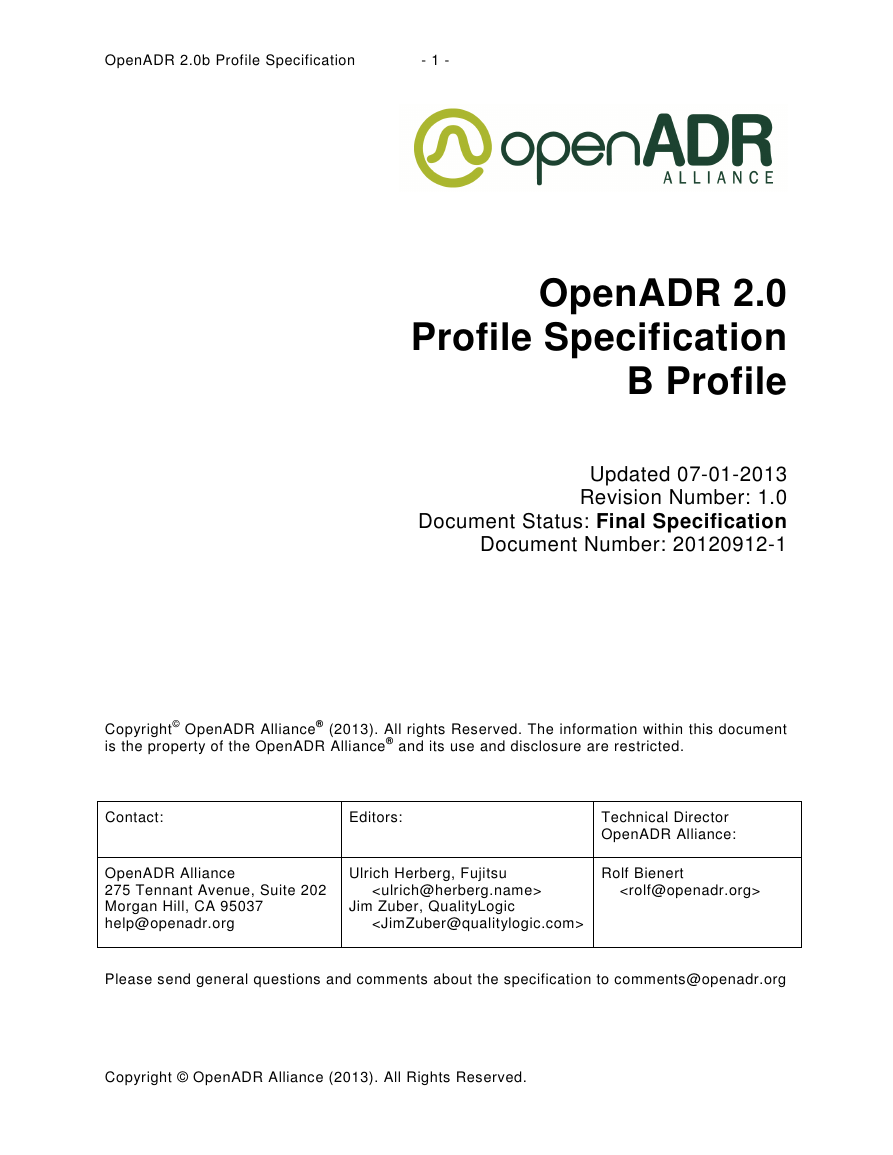
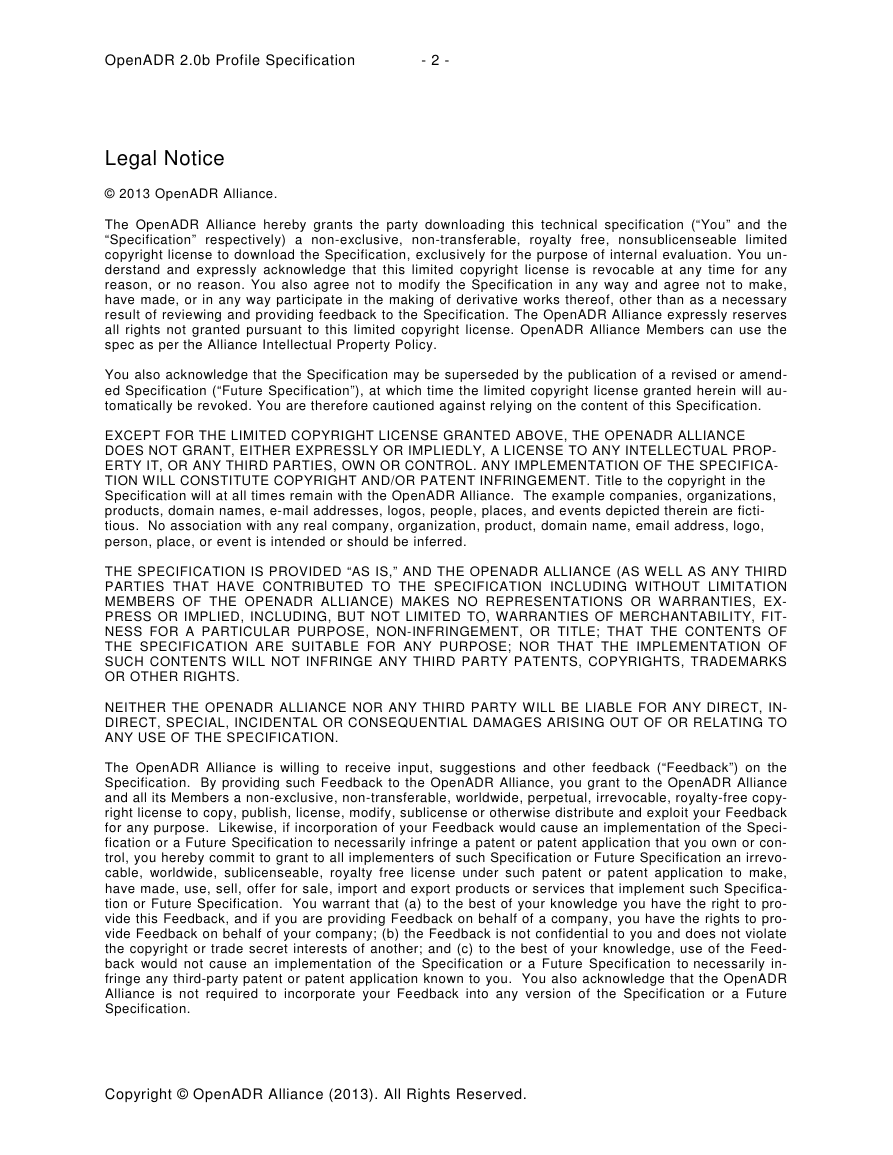
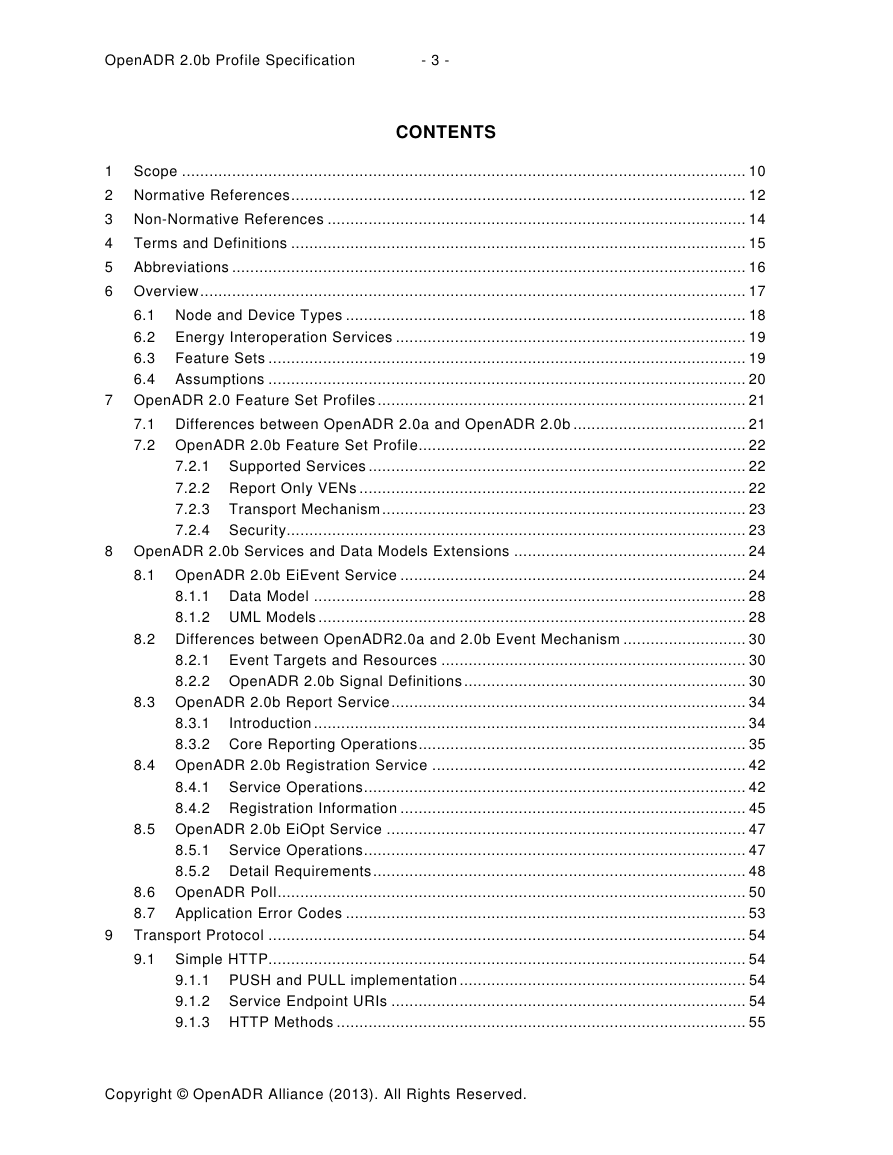


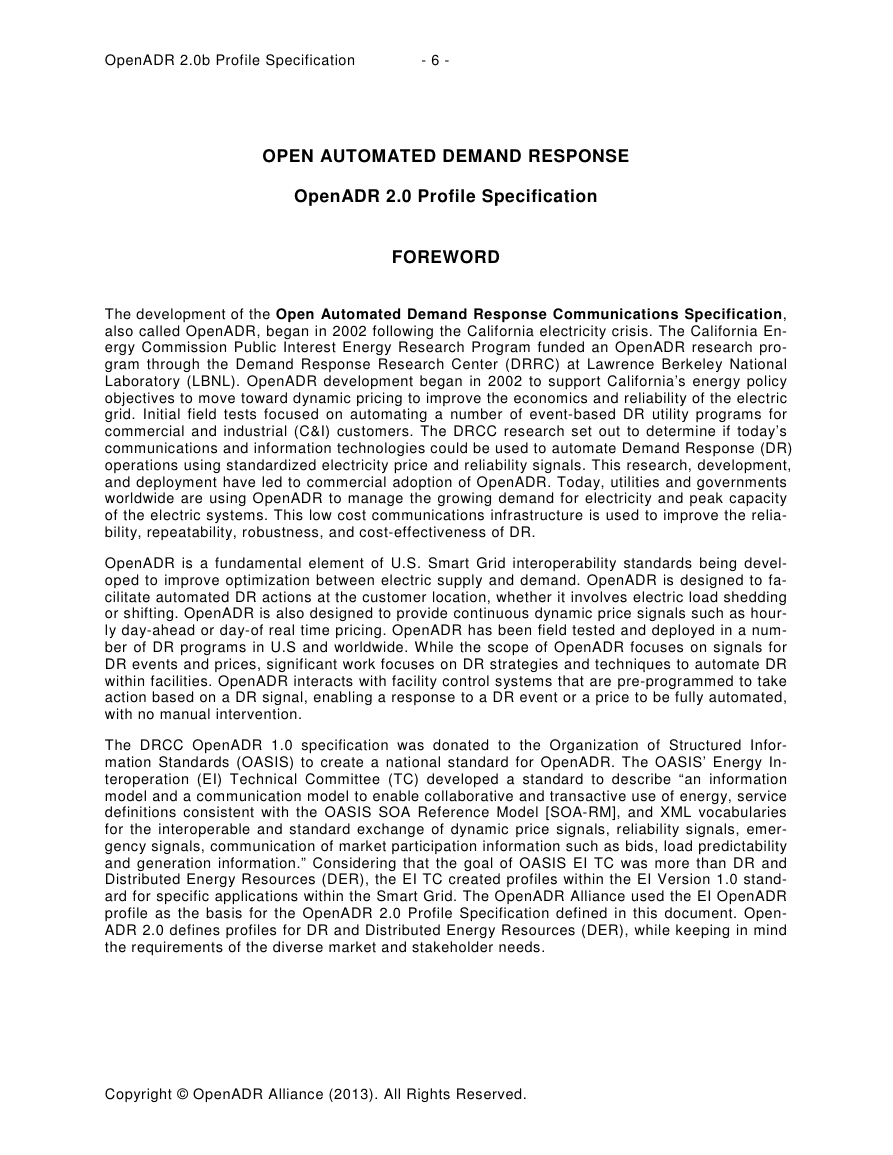
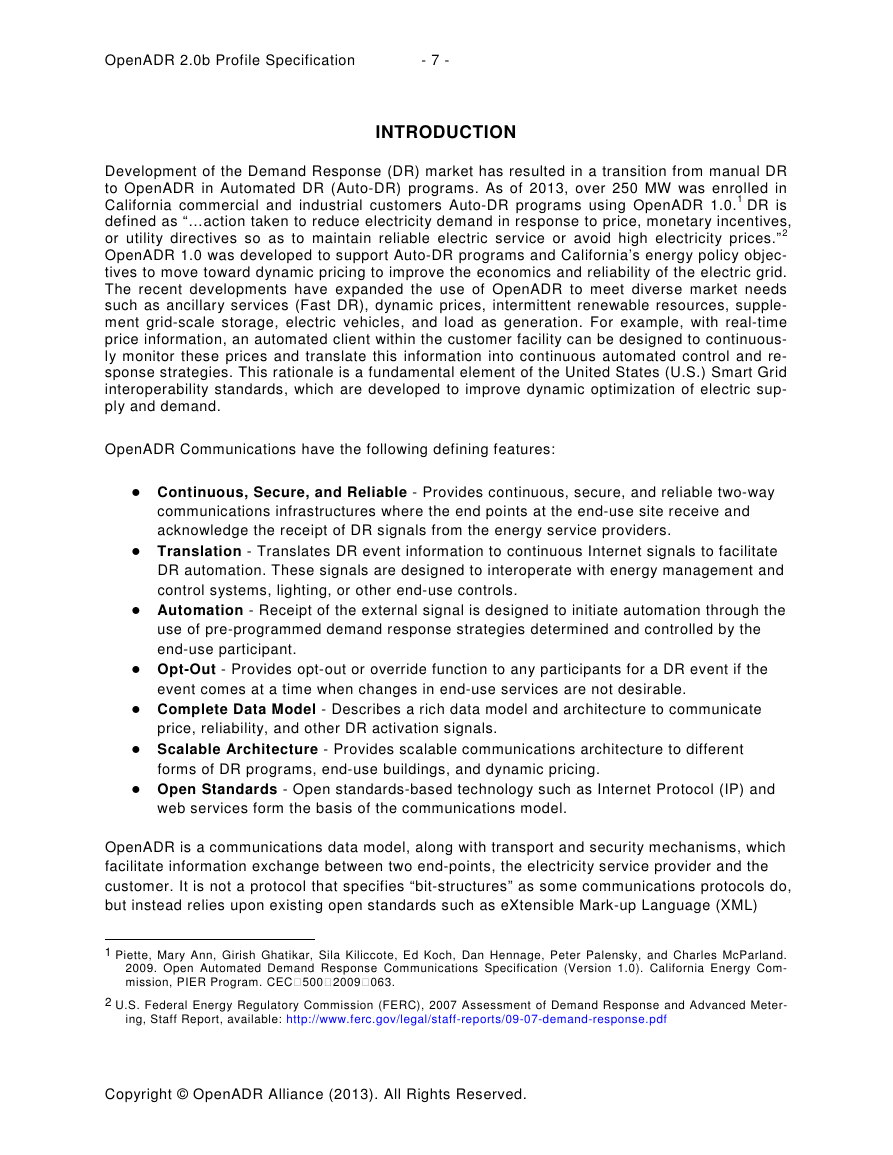
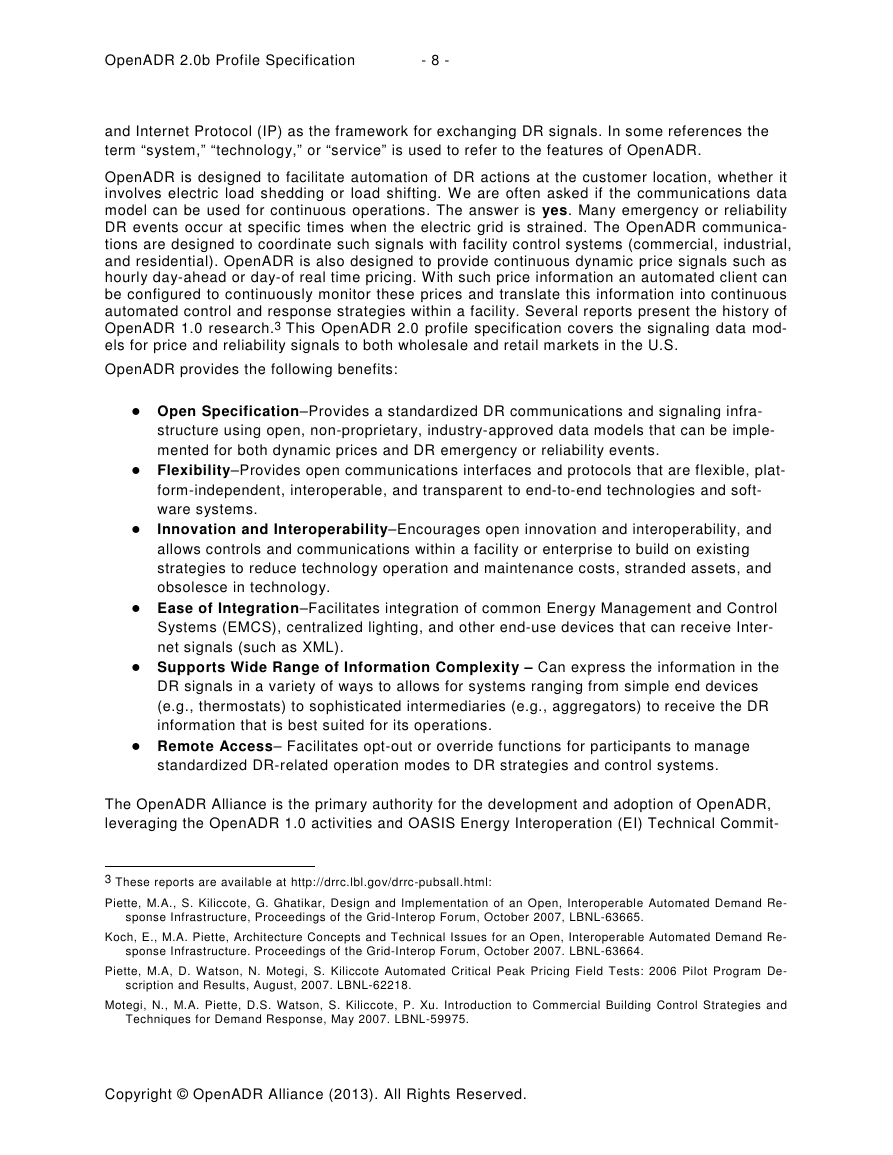








 2023年江西萍乡中考道德与法治真题及答案.doc
2023年江西萍乡中考道德与法治真题及答案.doc 2012年重庆南川中考生物真题及答案.doc
2012年重庆南川中考生物真题及答案.doc 2013年江西师范大学地理学综合及文艺理论基础考研真题.doc
2013年江西师范大学地理学综合及文艺理论基础考研真题.doc 2020年四川甘孜小升初语文真题及答案I卷.doc
2020年四川甘孜小升初语文真题及答案I卷.doc 2020年注册岩土工程师专业基础考试真题及答案.doc
2020年注册岩土工程师专业基础考试真题及答案.doc 2023-2024学年福建省厦门市九年级上学期数学月考试题及答案.doc
2023-2024学年福建省厦门市九年级上学期数学月考试题及答案.doc 2021-2022学年辽宁省沈阳市大东区九年级上学期语文期末试题及答案.doc
2021-2022学年辽宁省沈阳市大东区九年级上学期语文期末试题及答案.doc 2022-2023学年北京东城区初三第一学期物理期末试卷及答案.doc
2022-2023学年北京东城区初三第一学期物理期末试卷及答案.doc 2018上半年江西教师资格初中地理学科知识与教学能力真题及答案.doc
2018上半年江西教师资格初中地理学科知识与教学能力真题及答案.doc 2012年河北国家公务员申论考试真题及答案-省级.doc
2012年河北国家公务员申论考试真题及答案-省级.doc 2020-2021学年江苏省扬州市江都区邵樊片九年级上学期数学第一次质量检测试题及答案.doc
2020-2021学年江苏省扬州市江都区邵樊片九年级上学期数学第一次质量检测试题及答案.doc 2022下半年黑龙江教师资格证中学综合素质真题及答案.doc
2022下半年黑龙江教师资格证中学综合素质真题及答案.doc